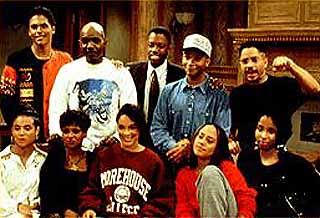Throughout this past week I have been observing and listening for verbal microaggressions on television and in person. I’ve detected more microaggressional conversations taking place on television than in person.
 Fred Sanford is always using the microassult form of microaggression when speaking to Julio, because he is Puerto Rican or Rollo, because he is an African American who Fred referred to as a convict on the sitcom Sanford and Son. Fred is constantly making derogatory remarks about their culture.
Fred Sanford is always using the microassult form of microaggression when speaking to Julio, because he is Puerto Rican or Rollo, because he is an African American who Fred referred to as a convict on the sitcom Sanford and Son. Fred is constantly making derogatory remarks about their culture.  In the movie White Men Can’t Jump, Wesley Snipes basically tells Woody Harrelson that he can’t slam-dunk a basketball because he is not black. This was an example of racial microaggression.
In the movie White Men Can’t Jump, Wesley Snipes basically tells Woody Harrelson that he can’t slam-dunk a basketball because he is not black. This was an example of racial microaggression.  On the sitcom A Different World, Ron Johnson who is an African American college student, was taking bets on a football game from a couple of Caucasian rivalries. Ron’s team won and his rivalries got upset and called him a Niger. This was definitely a form of Microassult in that it was an overt, hostile act intended to humiliate and belittle Ron’s character.
On the sitcom A Different World, Ron Johnson who is an African American college student, was taking bets on a football game from a couple of Caucasian rivalries. Ron’s team won and his rivalries got upset and called him a Niger. This was definitely a form of Microassult in that it was an overt, hostile act intended to humiliate and belittle Ron’s character. Another sitcom that encourages or depicts microaggressions is All in the Family; Archie Bunker
 plays a prejudice Caucasian who treats anyone outside of his race as though they are inferior to him. His behavior is the result of microinsults in that he belittles minority’s racial heritage.
plays a prejudice Caucasian who treats anyone outside of his race as though they are inferior to him. His behavior is the result of microinsults in that he belittles minority’s racial heritage. Even though all of these are individuals acting out various scenarios to make the audience laugh, it sends the public the wrong message and that is that it is okay to treat people this way and that one person is superior to others. All of my examples above are from television shows or a movie, but what happens in real life situations. This week, I was speaking with my supervisor concerning the program’s policy of taking food back to the kitchen. My supervisor implied that it was okay to take the food back to the kitchen to be thrown out, but I informed her that it is unsanitary practice to take the food back to the kitchen and that it should be disposed of in the trashcan in the classrooms. My supervisor said “You people” then she looked at the expression on my face and stopped and said “when I say you people, I don’t mean you specifically, I mean the base as a whole, do things differently here.” I told her about my assignment for this week and that I was going to share her comment with the class. I told her that she had just demonstrated an act of microinvalidation in that her comment made me feel marginalized, even though she didn’t intentionally mean to insult or hurt me (Laureate Education, Inc,). I felt that she grouped me with others rather than respecting my view as an individual with valid reasoning capabilities.
This remark of “You people” reminded me of the scenario in our discussion question. It seems so easy to lose one’s identity and become viewed as a group because of society’s norms. I felt that my supervisor felt that her way was the right way regardless of the policy and that my way was wrong. I didn’t feel inferior because of the knowledge I had gained through my assignments and readings this week, but I did feel that she thought she was superior. I do realize that she spoke without thinking and as a result of her unintentional act; I was able to see a glimpse of one of her hidden biases. I hope that after sharing my assignment with her it will make her more aware of those hidden biases. Regardless if they are intentional or unintentional, microaggressions can be detrimental to the person on the receiving end. We all have hidden biases and prejudices that we need to acknowledge so that we can take steps to minimize them. We must first begin by getting to know each other as individuals and learn to accept and appreciate other’s culture by integrating them within our classrooms.
Laureate Education, Inc. (Producer). Microaggressions in Everyday Life (2011) [DVD] Perspectives on Diversity and Equity. Baltimore, MD: Author.


![Family Bible-NIV[Hardcover] Family Bible-NIV[Hardcover]](http://a4.bing.com/thumb/get?bid=yMpgsGeE3pLDbw&bn=CC&fbid=7wIR63%2bClmj%2b0A&fbn=CC)